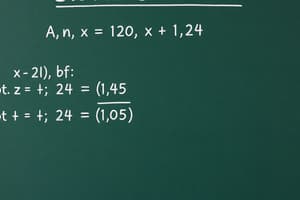Podcast
Questions and Answers
What is the formula for the Population Mean?
What is the formula for the Population Mean?
- μ = (P₁ * n₁ + P₂ * n₂) / (n₁ + n₂)
- μ = Σ ( Xi - μ )² / N
- μ = ( Σ Xi ) / N (correct)
- μ = ( Σ xi ) / n
What is the formula for the Population Standard Deviation?
What is the formula for the Population Standard Deviation?
- σ = sqrt [ Σ ( Xi - μ )² / N ] (correct)
- σ = (X - μ) / σ
- σ = Σ (xi - μ)² * P(xi)
- σ = sqrt [ Σ ( xi - x̄ )² / ( n - 1 ) ]
What is the formula for the Population Variance?
What is the formula for the Population Variance?
- σ² = Σ ( Xi - μ )² / N (correct)
- σ² = Σ ( xi - x̄ )² / ( n - 1 )
- σ² = (Σ xi) / n
- σ² = μ - sqrt (PQ / n)
Which formula represents the Variance of Population Proportion?
Which formula represents the Variance of Population Proportion?
What does Z represent in the context of a Standardized Score?
What does Z represent in the context of a Standardized Score?
Which formula is used to calculate the Population Correlation Coefficient?
Which formula is used to calculate the Population Correlation Coefficient?
What is the formula for the Sample Mean?
What is the formula for the Sample Mean?
What is the formula for the Sample Standard Deviation?
What is the formula for the Sample Standard Deviation?
What does E(X) represent in the context of Expected Value?
What does E(X) represent in the context of Expected Value?
What is the formula for the Variance of X?
What is the formula for the Variance of X?
What does the formula z = (X - μ)/σ define?
What does the formula z = (X - μ)/σ define?
What does the Chi-square statistic formula represent?
What does the Chi-square statistic formula represent?
What is the formula for the Expected Value of the Sum of Random Variables?
What is the formula for the Expected Value of the Sum of Random Variables?
What does the formula for Standard Error of the Mean state?
What does the formula for Standard Error of the Mean state?
Flashcards are hidden until you start studying
Study Notes
Population Statistics
- Population Mean (μ): Calculated as the sum of all observations divided by the total number of observations (N).
- Population Standard Deviation (σ): Measures the dispersion of a population's values, calculated using the square root of the variance.
- Population Variance (σ²): Represents the average of the squared differences from the mean.
Proportions and Standard Scores
- Variance of Population Proportion (σp²): Computed as the product of the proportion of successes (P) and failures (Q) divided by the sample size (n).
- Standardized Score (Z): Indicates how many standard deviations an element is from the mean, calculated by subtracting the mean from the observation and dividing by the standard deviation.
Sample Statistics
- Sample Mean (x̄): The average of sample values, calculated similarly to the population mean but uses sample size (n).
- Sample Standard Deviation (s): Reflects the dispersion of sample data, calculated as the square root of the sample variance adjusted for degrees of freedom.
- Sample Variance (s²): Similar to population variance but divided by (n - 1) to correct for bias in estimation.
Combined Data Metrics
- Pooled Sample Proportion (p): Average of two sample proportions weighted by their respective sample sizes.
- Pooled Sample Standard Deviation (sp): A combined measure of the variability from two samples, factoring in their sizes.
Correlation and Regression
- Population Correlation Coefficient (ρ): A measure of the linear relationship between two variables in a population, taking into account their respective standard deviations.
- Sample Correlation Coefficient (r): Similar to the population measure but calculated using sample data.
- Simple Linear Regression Line (ŷ): Represents the estimated linear relationship, described by the equation of the line formed by coefficients.
- Regression Coefficient (b₁): Indicates the change in the dependent variable for a one-unit change in the independent variable, based on sample data.
Probability and Expectation
- Rule of Addition: Total probability of either event A or B occurring, calculated as the sum of their individual probabilities minus the probability of their intersection.
- Expected Value (E(X)): The mean of a random variable's distribution, calculated as the weighted sum of all possible values.
Variance in Probability
- Variance of X (Var(X)): Indicates the spread of a random variable, calculated as the expected value of the squared deviation from the mean.
- Importance of Independence: Variance of the sum or difference of independent random variables combines their variances.
Sampling Distributions
- Mean of Sampling Distribution: States that the mean of sample means will equal the population mean (μx̄ = μ).
- Standard Error of the Mean (σx̄): The standard deviation of sample means, calculated by dividing the population standard deviation by the square root of the sample size.
Errors in Estimation
- Standard Error of Proportion (SEp): Indicates the variability of the sample proportion from the true proportion, calculated using sample size and proportions.
- Standard Error of Difference for Means and Proportions: Formulae that quantify the variability in estimating differences between two means or proportions.
Factorials and Combinations
- Factorials (n!): The product of all positive integers up to n, with the convention that 0! = 1.
- Permutations (nPr): Counting the arrangements of n items taken r at a time using factorial notation.
- Combinations (nCr): Different ways to choose r items from n without regard to order, calculated using factorial relationships.
Studying That Suits You
Use AI to generate personalized quizzes and flashcards to suit your learning preferences.




